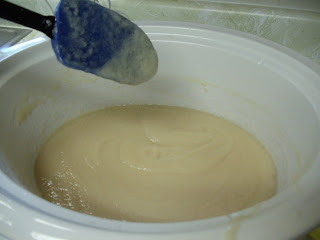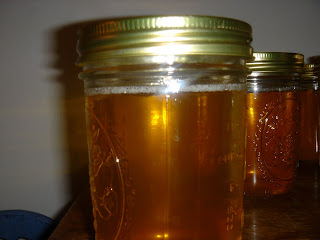So, if you are interested in the steps for making liquid soap I have them outlined below. I do not add any artificial colors to my liquid soap, so regardless of the scent, the soap is naturally a golden color. Adding herbs or botanicals for color would just clog up the pumping action so leaving it natural is my choice.
Safety First!

Gathering Tools
I use a crock pot to make my liquid soap in. It is much easier than using a double boiler!

Oils and Lye
I use Olive Oil, Coconut Oil, Castor Oil, Jojoba Oil, and Vegetable Glycerin.

Mixing the Lye Solution
When making Liquid Soap the Lye Solution is made using Potassium Hydroxide and Distilled Water. Measuring the Potassium Hydroxide first to then add to the Distilled Water.

Adding the Potassium Hydroxide to the Distilled Water

Measuring the Oils
After the Lye Solution is mixed I leave it alone until I get my oils measured.

Adding Oils to Crock Pot
I combine all the oils in the crock pot and set it on low so the oils melt gently.

Adding the Lye Solution to the melted oils
Once the oils have melted I then slowly add the lye solution to the crock pot.

Mixing the oils with the lye solution
Now comes the tedious part of this process. Using a stick blender I blend the oils and lye together until the mixture gets a good trace. The trace consistency for Liquid Soap is a bit thicker like a pudding consistency.

Reaching the Trace stage

Cooking the Soap Mixture
Now the soap needs to cook for 3 to 4 hours. The mixture must be stirred every 30 minutes or so. The mixture goes through multiple stages during the cooking time. The final stage of the cooking process produces a translucent vaseline type of consistency.

Diluting the soap mixture
Now is the tricky part of getting the soap mixture to blend with enough distilled water to get to the consistency for the final product. This is where I have goofed up a few times. I either added too much Distilled Water or not enough Distilled Water at this stage. I think I have finally found the correct measurements that I like for liquid soap. I boil the amount of Distilled Water I want to add to the soap paste first, then I add it to the crock pot and mix it around to combine the water and soap paste.

Waiting for complete dilution
Now it will take some time for the paste to completely incorporate with the water. I unplug the crock pot and normally leave it sit until the next morning.

The Final Steps
The next morning I usually have to take a potato masher to the remaining chunks of paste that didn't incorporate fully with the water. I turn the crock pot back on low and keep mashing these little chunks until they are all gone and everything in the crock pot is now incorporated fully. I then add a few tablespoons of a mixture of borax and water to neutralize the liquid soap to remove any excess lye in the mixture. Next I add vegetable glycerin for extra emolliency, then I add the essential oil for whatever fragrance I desire. I then unplug the crock pot and let the liquid soap cool. Once cool, I then pour the liquid soap into jars and let them rest for two weeks.

After two weeks I can then pour the liquid soap into soap dispensers. So, the process of making liquid soap is labor intensive but it is well worth the work to get a natural product that does not have any detergents or artificial ingredients added to it. Commercially made liquid soaps are most often detergents and leave the skin dry. Naturally handmade liquid soap will gently cleanse your skin and keep it soft and healthy.
Those are my thoughts for today!
Relax. Enjoy. Luxuriate.
Coleen

No comments:
Post a Comment